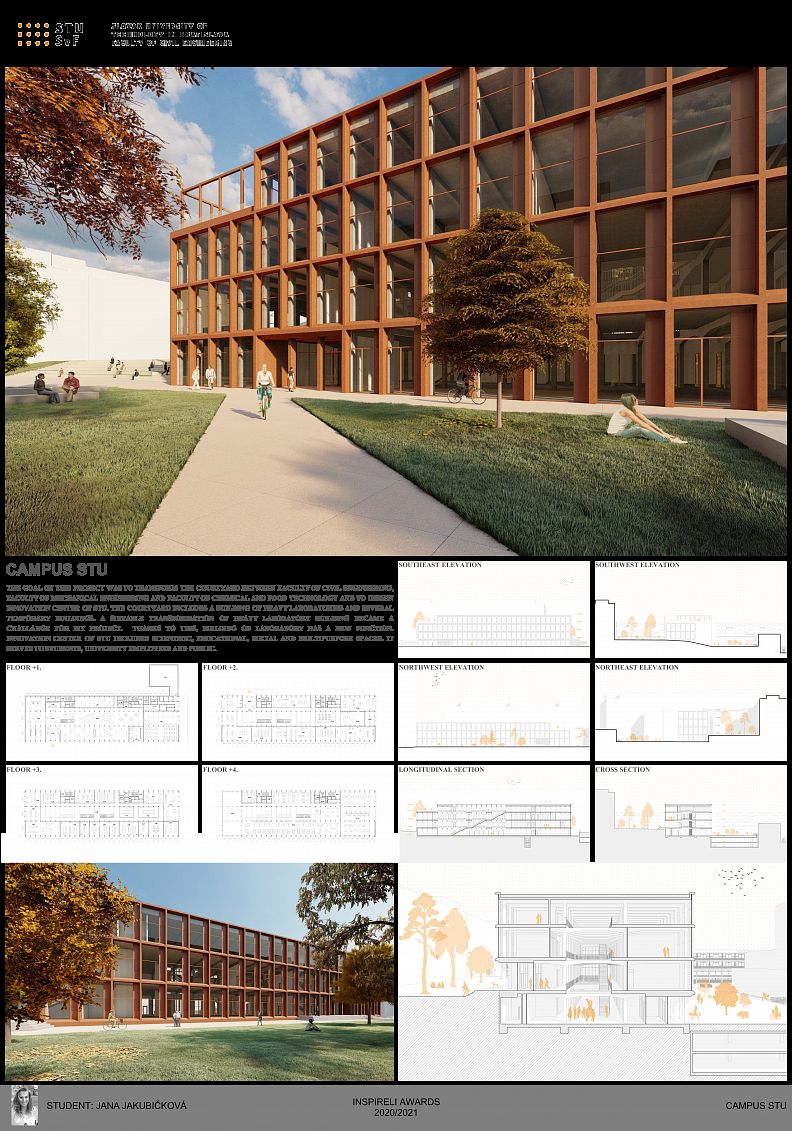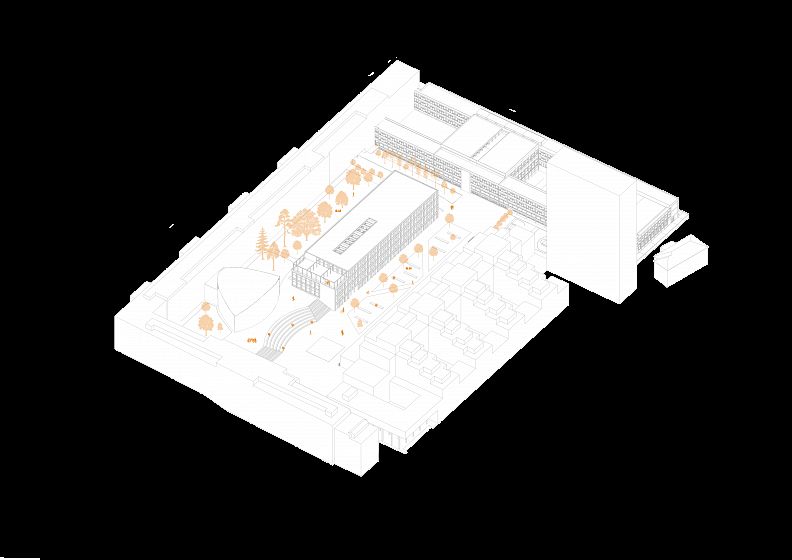Campus STU
Architecture
Project idea
Ideou projektu bolo zachovanie budovy ťažkých laboratórií a jej transformácia na novú funkciu. Pri návrhu som vychádzala z konceptu arch.
Kusého, ktorý navrhol pre SjF tri budovy (hlavná časť, Aula Maxima a budova ťažkých laboratorií). Ostatné budovy, ktoré sa v súčasnosti nachádzajú v areáli vznikali postupne pri výstavbe ďalších fakúlt. Preto som sa rozhodla areál očistiť od rušivých elementov a prinavrátiť mu pôvodnú čistotu.
The idea of the project was to preserve the heavy laboratory building and transform it into a new function. In the design, I based on the concept of arch.Kusý, who designed three buildings for the FME (main part, Aula Maxima and the building of heavy laboratories). Other buildings that are currently located in the area were gradually built during the construction of other faculties. Therefore, I decided to clean the area from disturbing elements and restore it to its original cleanliness.
Project description
Výsledný návrh vyšiel z analýzy územia a jednotlivých podkladov súťaže. Dôraz kladiem na odstránenie jednotlivých limitov či problémov areálu a prepojenie areálu s jednotlivými fakultami a okolím. Opieram sa o pôvodný koncept architekta Kusého s čistými plochami vnútrobloku. Navrhujem vznik nových vstupov z fakúlt do areálu, tak aby prišlo k oživeniu vnútrobloku a využívanie jeho plôch študentami, pedagógmi či verejnosťou vďaka opätovnému otvoreniu peších priechodov.
Návrh ponecháva pôvodné umiestnenie stavby aj jeho pôdorysné rozmery. Hmota však bola navýšená o jedno podlažie z dôvodu naplnenia kapacity zadaného lokalitného programu. Táto nová hmota bola odľahčená v juhozápadnej strane objektu (vznik strešnej terasy). Odľahčenie bolo zapríčinené zachovaním dôstojného odstupu od Auly Maxima.
Spájajúcim a dominantným prvkom budovy sa stala galéria, ktorá prepája všetky štyri podlažia. Galéria je silným prvkom v interiéri budovy, ktorý kopíruje pozdĺžnu os. Cez galériu prechádza schodisko prepájajúce prvé nadzemné podlažie s posledným. Na obvode budovy sú umiestnené všetky dielne, laboratóriá či kancelárie, tak aby využívali denné osvetlenie v maximálnej miere. Medzi týmito priestormi a galériou v strede budovy vzniká komunikácia, ktorá lemuje obe strany galérie.
The final proposal was based on an analysis of the territory and individual documents of the competition. I emphasize the elimination of individual limits or problems of the area and the connection of the area with individual faculties and the environment. I rely on the original concept of the architect Kusý with clean areas of the courtyard. I propose the creation of new entrances from the faculties to the campus, so that the courtyard will be revived and its areas will be used by students, teachers or the public thanks to the reopening of pedestrian passages.
The design retains the original location of the building and its floor plan dimensions. However, the mass was increased by one floor due to the filling of the capacity of the specified local program. This new mass was lightened in the southwest side of the building (creation of a roof terrace). The relief was caused by maintaining a dignified distance from Aula Maxima.
The connecting and dominant element of the building became the gallery, which connects all four floors. The gallery is a strong element in the interior of the building, which copies the longitudinal axis. A staircase passes through the gallery, connecting the first floor with the last. All workshops, laboratories or offices are located on the perimeter of the building, so that they use daylight to the maximum extent. There is a road between these spaces and the gallery in the middle of the building, which lines both sides of the gallery.
Technical information
Nosný systém budovy Inovačného centra (budova bývalých ťažkých laboratórií) je skelet. Pozostáva zo stĺpov prierezu 500 x 300 mm. Osové vzdialenosti v pozdĺžnom smere sú 3 000 mm a v priečnom smere 8 900 mm. Budova má 3 podlažia pôvodné. Štvrté podlažie je nadstavené, takisto s opakujúcim sa skeletovým nosným systémom zo spodnejších podlaží.
V návrhu vzniká galéria v pozdĺžnom smere budovy cez všetky podlažia. Z tohto dôvodu boli odstránené časti pôvodných stropných dosiek a prievlakov. Prievlaky boli odstránené v častiach novonavrhovaného schodiska kvôli zabezpečeniu podchodnej výšky. Časti prievlakov, ktoré ostávajú, budú musieť byť dodatočne zosilnené (stužené).
Obvodový plášť objektu pozostáva z ľahkého obvodového plášťa predsadeného pred pôvodné stropné dosky.
Hlavné deliace konštrukcie medzi komunikáciou a jednotlivými učebňami, dielňami či kanceláriami sú vo forme systémových sklenených priečok. Konkrétne kombinácia presklenej steny a plnej steny.
The supporting system of the Innovation Center building (the building of former heavy laboratories) is a skeleton. It consists of columns with a cross-section of 500 x 300 mm. The axial distances in the longitudinal direction are 3,000 mm and in the transverse direction 8,900 mm. The building has 3 original floors. The fourth floor is set up, also with a repeating skeletal support system from the lower floors.
The design creates a gallery in the longitudinal direction of the building across all floors. For this reason, parts of the original ceiling slabs and gutters have been removed. The gutters were removed in parts of the newly designed staircase to ensure the underpass height. The parts of the ducts that remain will have to be additionally reinforced.
The perimeter cladding of the building consists of a light perimeter cladding projected in front of the original ceiling slabs.
The main dividing structures between the communication and the individual classrooms, workshops or offices are in the form of system glass partitions. Specifically, a combination of a glass wall and a solid wall.
Documentation





















